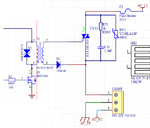kkawula
Newbie level 3
Hello,
I'm trying to design light dimmer for driving the LED bulbs.
Initially design was based on standard triac circuit with optocoupler. Unfortunately that solution wasn't especially good for driving low power LED bulbs at small PWM values.
I have searched internet and I found how to make alternative circuit with galvanic isolation provided by transformer. Circuit from the attachment has been built and tested. Every thing works ok, starting from very low PWM values to 100%.
Unfortunately now I have to face up different problem. From time to time, during connecting the load, I can observe that triac occasionally fires and blink could be observed.
I have tried triac which are not EMI sensitive like BTA312-800C, but it does not change anything.
Any ideas what can I improve and why triac fires?

Best regards
Krzysztof
I'm trying to design light dimmer for driving the LED bulbs.
Initially design was based on standard triac circuit with optocoupler. Unfortunately that solution wasn't especially good for driving low power LED bulbs at small PWM values.
I have searched internet and I found how to make alternative circuit with galvanic isolation provided by transformer. Circuit from the attachment has been built and tested. Every thing works ok, starting from very low PWM values to 100%.
Unfortunately now I have to face up different problem. From time to time, during connecting the load, I can observe that triac occasionally fires and blink could be observed.
I have tried triac which are not EMI sensitive like BTA312-800C, but it does not change anything.
Any ideas what can I improve and why triac fires?

Best regards
Krzysztof